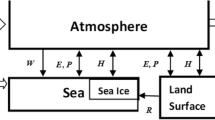Abstract—The trend of the dynamic state of Powell Basin waters in the Weddell Sea is estimated based on hydrological data from cruise 79 of the R/V Akademik Mstislav Keldysh (January 16–February 6, 2020) and World Ocean Database-2018 data for January–February 1975–2020. At each node of a quarter-degree grid, a linear trend was plotted for the calculated values of the maximum buoyancy frequency and maximum amplitude of the vertical internal wave velocity component. It is shown that the southwestern and northwestern parts of the Powell Basin differ significantly in their hydrophysical characteristics. In the northwest, the linear trend of the maximum buoyancy frequency is negative, while the depth trends of the maximum values of the Väisälä–Brunt frequency and amplitude of the vertical velocity component are positive. In the southwestern part of the basin, the opposite is true: the trend of the maximum buoyancy frequency is positive, while the trends in the depths of the maximum values of the Väisälä–Brunt frequency and the amplitude of the vertical velocity component are negative.










Similar content being viewed by others
REFERENCES
A. E. Bukatov and N. M. Solovei, “Evaluation of the density field vertical structure and the characteristics of internal waves relation with large-scale atmospheric circulation in the Peruvian and Benguela upwelling areas,” GEOmedia, No. 2, 485–490 (2017).
V. A. Gritsenko and V. P. Krasitskii, “On a method for the computation of dispersion relations and eigen functions for internal waves in the ocean from the field measurement data,” Okeanologiya, No. 4, 545–549 (1982).
A. V. Zimin, D. A. Romanenkov, I. E. Kozlov, B. Chapron, A. A. Rodionov, O. A. Atadjanova, A. G. Myasoedov, and F. Collard, “Short-period internal waves in the white sea: Operational remote sensing experiment in summer 2012,” Issled. Zemli Kosmosa, No. 3, 41–55 (2014) https://doi.org/10.7868/S0205961414030087
A. V. Klepikov and N. N. Antipov, “Formation and distribution of water masses on the shelf and continental slope around Antarctica,” Led i Sneg 54 (4), 81–94 (2014). https://doi.org/10.15356/2076-6734-2014-4-81-94
I. E. Kozlov, V. N. Kudryavtsev, E. V. Zubkova, et al., “Characteristics of short-period internal waves in the Kara Sea inferred from satellite SAR data,” Izv., Atmos. Ocean. Phys. 51 (9), 1073–1087 (2015). https://doi.org/10.1134/S0001433815090121
O. Yu. Krasnoborodko, “Internal waves in Bransfield Strait in February 2020 and their impact on krill distribution,” Trudy AtlantNIRO 5 (2), 81−89 (2021).
P. V. Lobovikov, O. E. Kurkina, A. A. Kurkin, and M. V. Kokoulina, “Transformation of first mode breather of internal waves above the bottom step in a three-layer fluid,” Izv., Atmos. Ocean. Phys. 55 (6), 650–661 (2019). https://doi.org/10.1134/S0001433819060094
Yu. Z. Miropol’skii, Dynamics of Internal Gravitational Waves at the Ocean (Leningrad, Gidrometeoizdat, 1981) [in Russian].
E. G. Morozov, V. A. Spiridonov, T. N. Molodtsova, et al., “Investigations of the ecosystem in the Atlantic sector of Antarctica (cruise 79 of the R/V Akademik Mstislav Keldysh),” Oceanology 60 (5), 721–723 (2020). https://doi.org/10.1134/S0001437020050161
E. G. Morozov, D. I. Frey, A. A. Polukhin, et al., “Mesoscale variability of the ocean in the northern part of the Weddell Sea,” Oceanology 60 (5), 573–588 (2020). https://doi.org/10.1134/S0001437020050173
V. A. Spiridonov, A. K. Zalota, V. A. Yakovenko, and K. M. Gorbatenko, “Composition of population and transport of juveniles of Antarctic krill in Powell Basin region (northwestern Weddell Sea) in January 2020,” Trudy VNIRO 18, 33–51 (2020). https://doi.org/10.36038/2307-3497-2020-181-33-51
An Atlas of Internal Solitary-like Waves and their Properties, 2nd ed. (2004). https://www.internalwaveatlas. com/Atlas2_index.html. Accessed September 1, 2022.
A. A. Bukatov, N. M. Solovei, and E. A. Pavlenko, “Free short-period internal waves in the Arctic seas of Russia,” Phys. Oceanogr. 28 (6), 599–611 (2021). https://doi.org/10.22449/1573-160X-2021-6-599-611
E. Fahrbach and A. Beckmann, “Weddell Sea circulation,” in Encyclopedia of Ocean Sciences (Elsevier, Amsterdam, 2001), Vol. 6, pp. 3201–3209.
A. E. Gill, “Circulation and bottom water production in the Weddell Sea,” Deep-Sea Res. 20 (2), 111–140 (1973).
G. Eagles and R. A. Livermore, “Opening history of Powell Basin, Antarctic Peninsula,” Mar. Geol. 185, 195–205 (2002). https://doi.org/10.1016/S0025-3227(02)00191-3
V. Klemas, “Remote sensing of ocean internal waves: An overview,” J. Coast. Res. 28 (3), 540–546 (2012). https://doi.org/10.2112/JCOASTRES-D-11-00156.1
R. D. Mueller and R. Timmermann, “Weddell Sea circulation,” in Encyclopedia of Ocean Sciences, 3rd ed. (2018), pp. 1–7. https://doi.org/10.1016/B978-0-12-409548-9.11631-8
Special report on the ocean and cryosphere in a changing climate. https://www.ipcc.ch/srocc/. Accessed October 1, 2022.
Funding
The study was carried out with a state task (topic no. FNNN-2022-0001).
Author information
Authors and Affiliations
Corresponding author
Rights and permissions
About this article
Cite this article
Bukatov, A.A., Solovei, N.M. & Pavlenko, E.A. Estimating Climate Trends of the Powell Basin’s Hydrophysical Characteristics. Oceanology 63, 464–471 (2023). https://doi.org/10.1134/S0001437023040021
Received:
Revised:
Accepted:
Published:
Issue Date:
DOI: https://doi.org/10.1134/S0001437023040021




